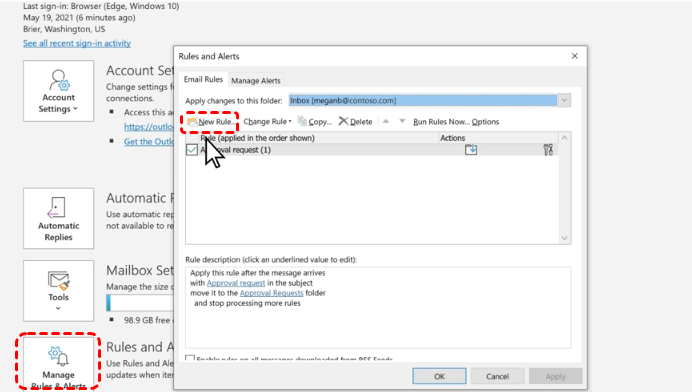What Are Rules in Outlook and Why Use Them?
Rules are automated actions that Outlook can perform on incoming and outgoing emails based on specific criteria. They can be as simple as moving emails from a specific sender to a particular folder or as complex as flagging important emails, deleting junk mail, or even forwarding messages to other recipients.
Why Use Rules?
- Save Time: Automate repetitive tasks and reduce manual sorting.
- Improve Organization: Keep your inbox clutter-free by automatically categorizing emails.
- Increase Productivity: Focus on important emails by filtering out less critical ones.
- Enhance Security: Prevent sensitive emails from being accidentally sent to the wrong people.
How to Set Up Email Rules in Outlook (Classic)
The process of setting up emails rules in Classic Outlook and New Outlook is quite different, and here we will first show you how to create rules in Outlook (Classic) step by step.
Step 1. Click on "Files" and then "Rules and Alerts" in the new window.
Step 2. In the "Rules Wizard" interface, click on "New Rule" to create a totally new rule for your Outlook account.
Step 3. Choose a template. For exmaple, you can Select "Flag messages from someone for follow-up".
Step 4. Edit the rule descriptions. Choose an underlined value, select the options you want, and then select "OK".
Step 5. Define Conditions and Actions:
- Conditions: Specify the criteria for the rule, such as: Sender's address Recipient's address Subject keywords Message importance Message flags Attachments Message size Message categories
- Actions: Choose the actions to be performed, such as: Move to a specific folder Copy to a specific folder Flag for follow-up Delete Forward to another recipient Mark as read or unread Add a specific category Review and Save:
Step 6. Carefully review the rule's settings to ensure it will work as intended. Click "Finish" to save the rule. If you want to use the rule right away, select the "Run this new rule now on messages already in the current folder" checkbox, and then select "OK".
Delet or Edit:
To delete an existing rule, just check the box in front of the target rule and click on "delete" option.
To change an existing rule, check the box in front of the target rule and click on "change rules" option. In the new pop-out window, redefine conditions and actions as you need.
How to Set Up Email Rules in Outlook (New)
Step 1. Access your Outlook account through a web browser.
Step 2. Click on the gear icon in the top-right corner and select "Settings".
Step 3. In the Settings pane, choose "Mail".
Step 4. Scroll down to the "Rules" section. First of all, input a name to manifest its purpose.
Step 5. Add conditions to the rule, such as specific sender or recipient addresses, to target specific emails for deletion. You can add severnal conditions simultaneously to filter the desired results more precisely.
Step 6. Add an action from the given list. For example, choose "Delete", which is quite useful to automatically delete some spam emails.
Step 7. Click "Save" to apply the settings.
Best Practices for Managing Multiple Rules in Outlook
- Start Simple: Begin with a few basic rules and gradually add more as needed.
- Keep It Organized: Use clear and concise rule names to easily identify their purpose.
- Document Your Rules: Create a reference document to explain the purpose and conditions of each rule.
- Regularly Review and Test: Periodically review your rules to ensure they are still working as intended.
Conclusion
With learning how to create and utilize Outlook rules, you can significantly improve your email management and productivity. By automating routine tasks, you can focus on more important activities and reduce stress. Remember to experiment with different rule combinations to find the best approach for your specific needs.
Bonus Tip: How to Manage and Back up Outlook Emails
This article addresses the question “how to set rules in Outlook?”. If you’re considering backing up your Outlook, MultCloud can be extremely useful. Trusted by over 3 million users, MultCloud is a multi-cloud management tool that facilitates the transfer or synchronization of files between various cloud services.
For instance, you can save your Outlook emails as PDFs to your computer or cloud drives, such as Google Drive, OneDrive, or Dropbox, in bulk. MultCloud also enables you to access and manage all your cloud or Email accounts via a single application. Currently, it supports more than 30 different cloud services, including Google Drive, OneDrive, Dropbox, Box, Google Photos, iCloud Photos, FTP, WebDav, and more.

- Cloud Transfer: MultCloud can transfer files from one cloud service to another directly without downloading and re-uploading.
- Cloud Sync: With MultCloud, you can easily sync two folders between different cloud services in real-time.
- Cloud Backup: You can backup and restore data between different cloud services automatically.
- Instagram Downloader: MultCloud can help you download Instagram videos, photos, reels and stories to local device or remotely upload them to your clouds.
- Email Migration: You can directly back up and save Gmail emails as PDFs to your computer or cloud drive in bulk.
- Manage all cloud accounts in one place: Connect all your clouds to MultCloud and you'll find it so easy to access and manage multiple cloud storage files with a single login.
MultCloud Supports Clouds
-
Google Drive
-
Google Workspace
-
OneDrive
-
OneDrive for Business
-
SharePoint
-
Dropbox
-
Dropbox Business
-
MEGA
-
Google Photos
-
iCloud Photos
-
FTP
-
box
-
box for Business
-
pCloud
-
Baidu
-
Flickr
-
HiDrive
-
Yandex
-
NAS
-
WebDAV
-
MediaFire
-
iCloud Drive
-
WEB.DE
-
Evernote
-
Amazon S3
-
Wasabi
-
ownCloud
-
MySQL
-
Egnyte
-
Putio
-
ADrive
-
SugarSync
-
Backblaze
-
CloudMe
-
MyDrive
-
Cubby







